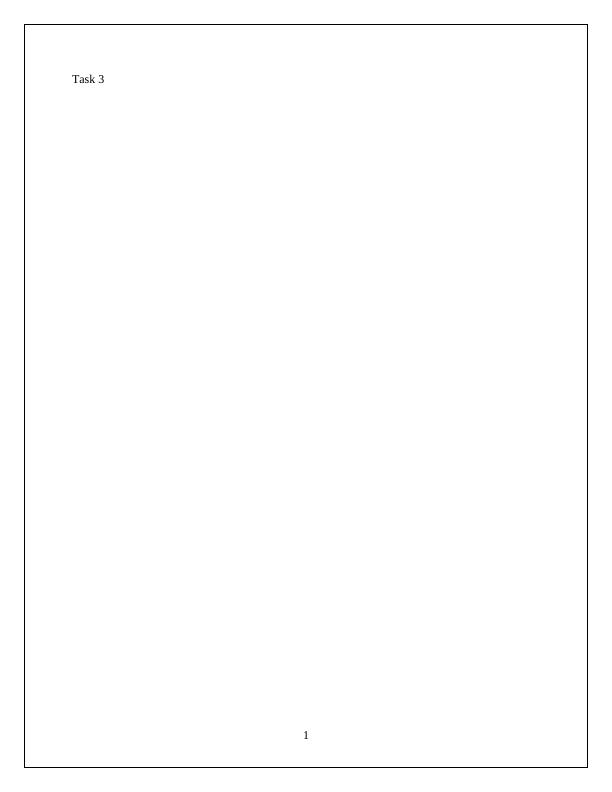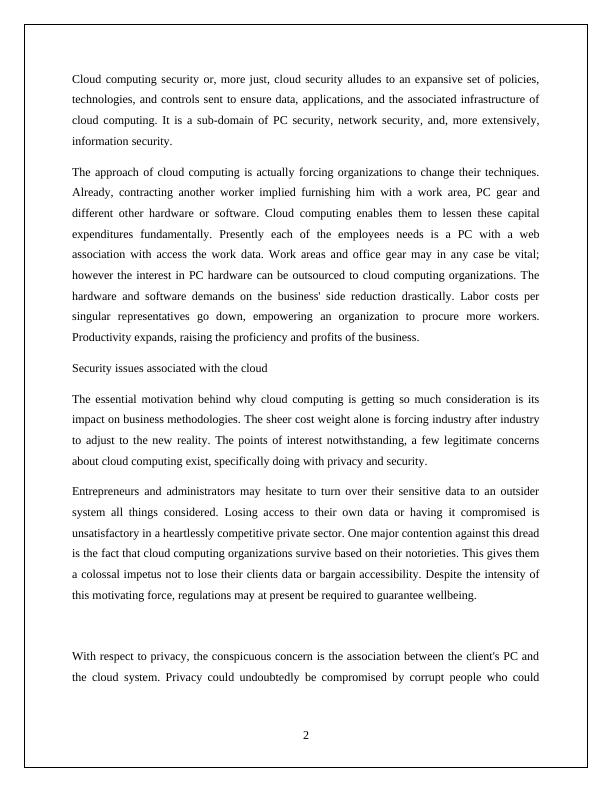Ask a question from expert
Cloud Computing Security
10 Pages2580 Words197 Views
Added on 2019-09-24
Cloud Computing Security
Added on 2019-09-24
BookmarkShareRelated Documents
Task 31

Cloud computing security or, more just, cloud security alludes to an expansive set of policies,technologies, and controls sent to ensure data, applications, and the associated infrastructure ofcloud computing. It is a sub-domain of PC security, network security, and, more extensively,information security. The approach of cloud computing is actually forcing organizations to change their techniques.Already, contracting another worker implied furnishing him with a work area, PC gear anddifferent other hardware or software. Cloud computing enables them to lessen these capitalexpenditures fundamentally. Presently each of the employees needs is a PC with a webassociation with access the work data. Work areas and office gear may in any case be vital;however the interest in PC hardware can be outsourced to cloud computing organizations. Thehardware and software demands on the business' side reduction drastically. Labor costs persingular representatives go down, empowering an organization to procure more workers.Productivity expands, raising the proficiency and profits of the business.Security issues associated with the cloud The essential motivation behind why cloud computing is getting so much consideration is itsimpact on business methodologies. The sheer cost weight alone is forcing industry after industryto adjust to the new reality. The points of interest notwithstanding, a few legitimate concernsabout cloud computing exist, specifically doing with privacy and security. Entrepreneurs and administrators may hesitate to turn over their sensitive data to an outsidersystem all things considered. Losing access to their own data or having it compromised isunsatisfactory in a heartlessly competitive private sector. One major contention against this dreadis the fact that cloud computing organizations survive based on their notorieties. This gives thema colossal impetus not to lose their clients data or bargain accessibility. Despite the intensity ofthis motivating force, regulations may at present be required to guarantee wellbeing. With respect to privacy, the conspicuous concern is the association between the client's PC andthe cloud system. Privacy could undoubtedly be compromised by corrupt people who could2

access individual information like credit card numbers. An answer for this issue is to utilizeauthentication and encryption like customary secure associations. These practical concerns are to some degree eclipsed by various philosophical and lawfulinquiries. While it is held in the customer's name, a case could possibly be made that the cloudcomputing system is the actual proprietor and therefore has a privilege to it. These technicalitiesare still under open deliberation, and no determination has yet been accomplished.Cloud computing and storage gives users capabilities to store and process their data in outsiderdata centers Organizations utilize the cloud in a wide range of service models (with acronyms,for example, SaaS, PaaS, and IaaS) and deployment models (private, public, hybrid, andcommunity). Security concerns associated with cloud computing fall into two general categories:security issues looked by cloud providers (organizations giving software-, platform-, orinfrastructure-as-a-service by means of the cloud) and security issues looked by their customers(organizations or organizations who host applications or store data on the cloud).Theresponsibility is shared, be that as it may. The supplier must guarantee that their infrastructure issecure and that their clients' data and applications are ensured, while the client must takemeasures to fortify their application and utilize strong passwords and authentication measures. At the point when an organization chooses to store data or host applications on the public cloud,it loses its ability to have physical access to the servers hosting its information. Accordingly,potentially sensitive data is in danger from insider attacks. According to an ongoing CloudSecurity Alliance report, insider attacks are the 6th greatest risk in cloud computing. Therefore,cloud service providers must guarantee that thorough personal investigations are directed forrepresentatives who have physical access to the servers in the data focus. Additionally, datacenters must be as often as possible monitored for suspicious activity. In order to moderate resources, cut costs, and look after productivity, cloud service providersoften store more than one client's data on a similar server. Accordingly, there is a possibility thatone client's private data can be seen by other users (possibly even competitors). To handle suchsensitive situations, cloud service providers ought to guarantee appropriate data disengagementand logical storage isolation. 3

End of preview
Want to access all the pages? Upload your documents or become a member.
Related Documents
Challenges in Cloud Computing- Reportlg...
|13
|4086
|213
Cloud Computing Security: Challenges and Solutionslg...
|13
|4040
|461
Security and Privacy Issues in the Cloud Computinglg...
|10
|1820
|74
Security and Privacy Issues and Prevention Methods in Cloud Computinglg...
|4
|4001
|93
(PDF) Cloud Computing Assignmentlg...
|3
|2868
|157
Security and privacy issues in cloud computing.lg...
|1
|288
|167